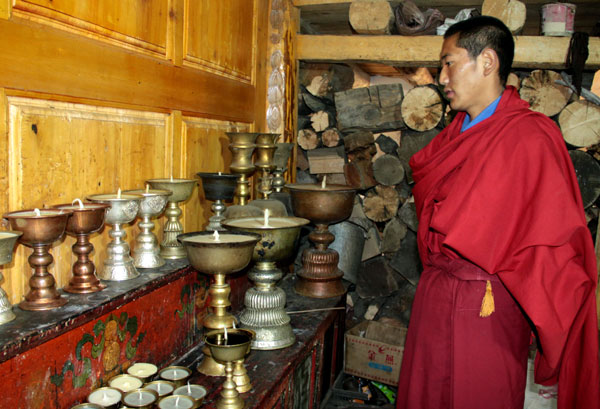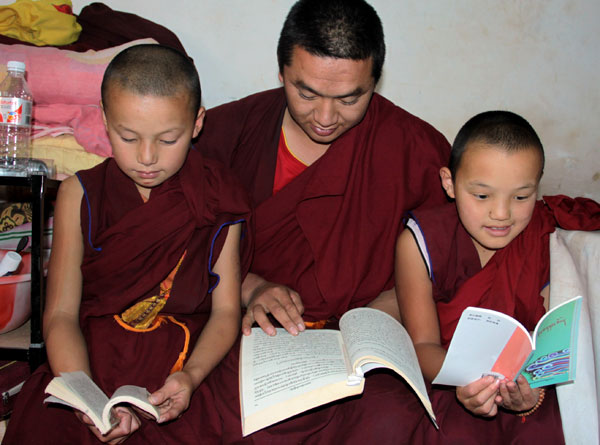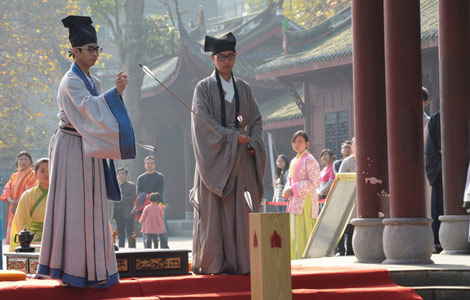The way of kindness
Updated: 2013-11-18 07:44
By Hu Yongqi and Li Yingqing in Shangri-La, Yunnan (China Daily)
|
|||||||||||
Friends and neighbors
In the 10-square-meter dorms, each monk has one cabinet to store his books, meager clothing and other daily necessities. A painting of the Buddha Sakyamuni has been posted on the wall, "watching them (the students) strenuously study the classics", as the young monks put it.
 |
|
Lhasang Pasang from Ganden Sumtsenling Monastery selects a butter lamp for a visitor. hu yongqi / China Daily |
Every day, Tengpa Gyestang and his classmates begin reading the classics at 7:30. They finish at midday, when they eat, before joining the debating class in the afternoons. "From the scriptures, I began to understand some of the fundamentals of Buddhism. My ambition is to obtain the Geshe degree in 10 years - there are so many profound elements to comprehend," said Tengpa Gyestang, who has been studying at the monastery for 10 years, along with his roommates.
Dondrup Ling Monastery, which was re-established in 1982, is the second largest in Diqing. It recruits boys from three townships in the county and is home to more than 400 monks and trainees, aged from 9 years old to 70. Monks who have already graduated from the class chanted the scriptures in the main hall where visitors pray to the Buddha and make donations. Tengpa Gyestang's classroom is located 100 meters down the main hall in a tranquil atmosphere designed to ensure that the scholars can devote themselves to their studies free from outside interruptions.
 |
|
Three monks study Tibetan Buddhist scriptures in their dorm at Dondrup Ling Monastery. Hu Yongqi / China Daily |
Every year, the monks are granted three months' leave. They can either stay at the monastery and continue their studies, or they can return to their home villages and chant for their neighbors. "Monks are revered in the villages because no one can replace them at crucial occasions such as funerals," said Drukpa Dentsin, headmaster of the class.
During the past three decades, Dondrup Ling's infrastructure and management has undergone a series of dramatic changes, said Lurung Gyaltso, the president of the monastery. In the early 1980s, a new temple was constructed to replace the existing building, which was on the verge of collapse. The Living Buddha drove a truck to ferry timber from the trees that had been felled by local ethnic Tibetans. At the time, there was so little food that the monks and laborers dreamed of corn cakes, but no one complained about the harsh conditions high on the mountain, according to Lurung Gyaltso.
"The monastery couldn't be built without the help of the neighboring communities," he said.
The five-year joint plan finally paid off in 1987 when a new temple, featuring an imposing main hall and dormitories, was finally opened. Some of the monks - each of whom was also given a two-story house - decorated the new temple with Buddhist paintings, according to a lama called Lobsang Dorje.
In Tibetan temples, believers routinely pray and donate money, and in return, the monastery calls on its disciples for donations and help for the residents in the event of natural disasters. After a series of earthquakes that began in late August, the Living Buddha at Dondrup Ling Monastery, has donated 20,000 yuan ($3,229) to the rescue and reconstruction operations.
Other establishments also helped: For example, the largest Tibetan temple in Yunnan, Ganden Sumtsenling Monastery in Shangri-La, the capital of the prefecture, raised 240,000 yuan for victim relief and held a special ceremony to chant sutras.
"As the economy has developed, the local Tibetans have become wealthier and so they willingly increased the size of their donations to the monastery," said Lurung Gyaltso. "Therefore, we have to do something if they come across difficult times."
The monks have also taken on the role of educating the locals about environmental protection. Diqing's ecosystem had deteriorated severely by the time a once-booming logging industry came to an end 15 years ago. Now, the monks emphasize the need to conserve nature and keep telling believers to cut down as few trees as possible to save the barren land and waning woodland on the mountains, according to Drukpa Dentsin. "Tibetan Buddhism aims for the peaceful utilization of natural resources and so we always urge our followers to follow the rules," he said.
Related Stories
Lama wants Sagya Monastery to join World Heritage list 2013-01-25 00:08
New life for monks in rebuilt monasteries 2012-11-16 17:26
Living Buddha's blessing 2011-04-22 07:08
Today's Top News
Boeing airliner crashes in Russia, 50 killed
Lanzhou takes lead to curb car use
EU, China in right direction
Bringing China's best minds home
Abe busy in ASEAN at Beijing
China police nab 4 drug suspects
President Xi meets Dutch PM
Decisive market tackles overcapacity
Hot Topics
Lunar probe , China growth forecasts, Emission rules get tougher, China seen through 'colored lens', International board,
Editor's Picks

|

|

|

|

|

|





